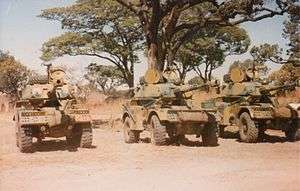Operation Miracle (Rhodesia)
Operation Miracle or Battle of Mavonde was a military raid by the Rhodesian Security Forces (RSF) against ZANLA guerrilla bases in Mozambique towards the end of the Rhodesian Bush War. ZANLA put up stiff resistance and the tactical success of the RSF did not lead to the expected strategic changes.
| Operation Miracle (or the Battle of Mavonde) | |||||||
|---|---|---|---|---|---|---|---|
| Part of the Rhodesian Bush War (or Second Chimurenga) | |||||||
 Eland-90 armoured cars of the Rhodesian Armoured Corps. | |||||||
| |||||||
| Belligerents | |||||||
|
|
| ||||||
| Commanders and leaders | |||||||
|
|
| ||||||
| Units involved | |||||||
|
| Mavonde base | ||||||
| Strength | |||||||
| 200 | 6,000 | ||||||
| Casualties and losses | |||||||
|
8 killed 3 wounded 2 warplanes shot down 2 helicopters destroyed |
ZANLA: unknown Frelimo: 1 tank destroyed | ||||||
Background
After successful Rhodesian air attacks on ZANLA bases, such as Operation Snoopy, the guerilla chose to set a new camp under the shelter of the forest near Mavonde, a few kilometers from Chimoio. As the Lancaster House discussions were taking place, RSF attempted to annihilate this base,[1] hoping to weaken the Zimbabwean position.[2]
The base was held by 6,000 ZANLA partisans, with many anti-aircraft weapons on hills. Many guns were located on the highest hill, later to be nicknamed "Monte Cassino".[1] Two secondary hills, Hill 774 and Hill 761, were also dotted with anti-aircraft guns.[3] Trenches were dug in the 64-square-kilometers surface of the camp.[2] The base was commanded by Solomon Mujuru, known by his nom-de-guerre Rex Nhongo. These weapons were received from the Ethiopian Derg.[4]
Small-scale Rhodesian reconnaissances erroneously estimated the ZANLA force to be 2,000 men strong.[2] 200 Rhodesian soldiers were engaged. 100 men of the Selous Scouts were to spearhead the raid.[2] Each of the ten-men was transported in a Unimog truck. The whole column, commanded by captain Richard Passaportis,[5] contained 20 Unimogs, protected by Eland-90 armoured cars of the Rhodesian Armoured Corps.[6] A detachment of QF 25-pounder guns was also part of the column.[5] The Selous Scouts were supported by 100 men of the Rhodesian Light Infantry (2 Commando, 3 Commando and Support Commando[7]), air-dropped 10-kilometers away from the camp.[6]
First day
Before attacking the base, the RSF ground forces had to cross a river. The artillery was bogged down and the guerilla was alerted of the size of the column.[5] The column was further delayed by ZANLA fire.[4][5] The first wave of the Selous Scouts began clearing the trenches but the rest of the column only arrive late in the afternoon.[5] Meanwhile, the airdropped Rhodesian Light Infantry joined the battle and Mpunzarima, a key ZANLA military leader, was killed.[4] At dawn, Nhongo distributed marijuana to some of his troops, to reduce their stress.[8] The Rhodesian troops were harassed during the night by RPG-7s, recoilless-rifles and mortars.[5]
Second day
RSF renewed its assault. Nhongo personally went to the front to increase the moral of his troops, using a big stick to hit the reluctants.[8] Guided by a Westland Lynx helicopter, Hawker Hunter attack jets neutralized ZANLA fortifications in Hill 774. The position was taken at 3 pm by a troop of the Selous Scouts.[3] English Electric Canberra bombers also bombed the anti-aircraft positions.[6]
Third day
During the night, RSF artillery fired at ZANLA positions, not to make damages but to prevent the partisans to rest.[8] At 10 am, two troops of Selous Scouts and a RLI section (around 100 men) led an assault to Monte Cassino. The summit was taken after the partisans had retreated, as was Hill 761.[9] At the end of that day, Nhongo ordered his fighters to retreat[10] During the late night, FRELIMO sent three or more T-34 or T-54 tanks[7][8][9] and a squad of infantry to support the Rhodesian rebels but RSF 25-pounders quickly reacted, guided by Rhodesian SAS, and the tanks retreated after the lead tank was put out of action.[8][9]
Consequences
The Rhodesian force withdrew on the next morning,[9] taking captured equipment with them.[11] To avoid retaliation attacks from Mozambique, the Rhodesian Air Force bombed FRELIMO facilities but one Camberra and one Hunter were shut down.[9] The battle had no consequences on the Lancaster House discussions.[1]
References
- Tendi 2020, p. 110.
- Moorcraft & McLaughlin 2008, p. 114.
- Baxter 2011, p. 133.
- Tendi 2020, p. 111.
- Baxter 2011, p. 132.
- Moorcraft & McLaughlin 2008, p. 116.
- Wessels & Scheepers 2018, p. 160.
- Tendi 2020, p. 112.
- Baxter 2011, p. 136.
- Tendi 2020, p. 113.
- Baxter 2011, p. 135.
External links
- Baxter, Peter. "Selous Scouts Operation Miracle".
Bibliography
- Geldenhuys, Preller (13 July 2007). Rhodesian Air Force Operations with Air Strike Log. Durban, South Africa: Just Done Productions Publishing. ISBN 978-1-920169-61-9.CS1 maint: ref=harv (link)
- Tendi, Blessing-Miles (2020). "The Longest Time". The Longest Time. In The Army and Politics in Zimbabwe: Mujuru, the Liberation Fighter and Kingmaker. Cambridge: Cambridge University Press. pp. 96–124. doi:10.1017/9781108561600.005.CS1 maint: ref=harv (link)
- Moorcraft, Paul L; McLaughlin, Peter (April 2008) [1982]. The Rhodesian War: A Military History. Barnsley: Pen and Sword Books. ISBN 978-1-84415-694-8.CS1 maint: ref=harv (link)
- Baxter, Peter (2011). Selous Scouts: Rhodesian Counter-Insurgency Specialists. Helion & Company Limited and South Publishers (Pty) Ltd. ISBN 978-1-907677-38-0.CS1 maint: ref=harv (link)
- Wessels, Hannes; Scheepers, Andre (2018). We Dared to Win: The SAS in Rhodesia. Casemate. ISBN 9781612005874.CS1 maint: ref=harv (link)